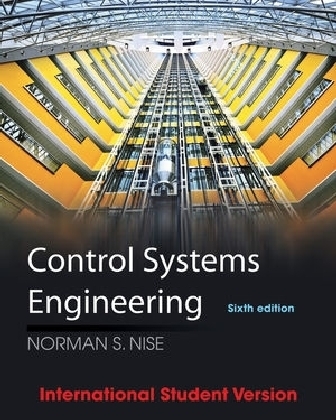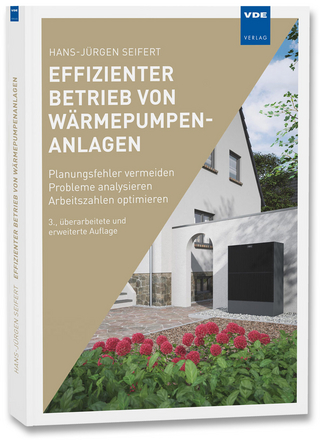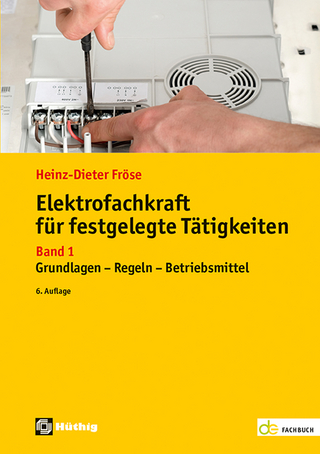
Control Systems Engineering
John Wiley & Sons Ltd (Verlag)
978-0-470-64612-0 (ISBN)
- Titel ist leider vergriffen;
keine Neuauflage - Artikel merken
PREFACE, vii
1. INTRODUCTION, 1
1.1 Introduction, 2
1.2 A History of Control Systems, 4
1.3 System Configurations, 7
1.4 Analysis and Design Objectives, 10
Case Study, 12
1.5 The Design Process, 15
1.6 Computer–Aided Design, 20
1.7 The Control Systems Engineer, 21
Summary, 23
Review Questions, 23
Problems, 24
Cyber Exploration Laboratory, 30
Bibliography, 31
2. MODELING IN THE FREQUENCY DOMAIN, 33
2.1 Introduction, 34
2.2 Laplace Transform Review, 35
2.3 The Transfer Function, 44
2.4 Electrical Network Transfer Functions, 47
2.5 Translational Mechanical System Transfer Functions, 61
2.6 Rotational Mechanical System Transfer Functions, 69
2.7 Transfer Functions for Systems with Gears, 74
2.8 Electromechanical System Transfer Functions, 79
2.9 Electric Circuit Analogs, 84
2.10 Nonlinearities, 88
2.11 Linearization, 89
Case Studies, 94
Summary, 97
Review Questions, 97
Problems, 98
Cyber Exploration Laboratory, 112
Bibliography, 115
3. MODELING IN THE TIME DOMAIN, 117
3.1 Introduction, 118
3.2 Some Observations, 119
3.3 The General State–Space Representation, 123
3.4 Applying the State–Space Representation, 124
3.5 Converting a Transfer Function to State Space, 132
3.6 Converting from State Space to a Transfer Function, 139
3.7 Linearization, 141
Case Studies, 144
Summary, 148
Review Questions, 149
Problems, 149
Cyber Exploration Laboratory, 157
Bibliography, 159
4. TIME RESPONSE, 161
4.1 Introduction, 162
4.2 Poles, Zeros, and System Response, 162
4.3 First–Order Systems, 166
4.4 Second–Order Systems: Introduction, 168
4.5 The General Second–Order System, 173
4.6 Underdamped Second–Order Systems, 177
4.7 System Response with Additional Poles, 186
4.8 System Response With Zeros, 191
4.9 Effects of Nonlinearities Upon Time Response, 196
4.10 Laplace Transform Solution of State Equations, 199
4.11 Time Domain Solution of State Equations, 203
Case Studies, 207
Summary, 213
Review Questions, 214
Problems, 215
Cyber Exploration Laboratory, 228
Bibliography, 232
5. REDUCTION OF MULTIPLE SUBSYSTEMS, 235
5.1 Introduction, 236
5.2 Block Diagrams, 236
5.3 Analysis and Design of Feedback Systems, 245
5.4 Signal–Flow Graphs, 248
5.5 Mason s Rule, 251
5.6 Signal–Flow Graphs of State Equations, 254
5.7 Alternative Representations in State Space, 256
5.8 Similarity Transformations, 266
Case Studies, 272
Summary, 278
Review Questions, 279
Problems, 280
Cyber Exploration Laboratory, 297
Bibliography, 299
6. STABILITY, 301
6.1 Introduction, 302
6.2 Routh–Hurwitz Criterion, 305
6.3 Routh–Hurwitz Criterion: Special Cases, 308
6.4 Routh–Hurwitz Criterion: Additional Examples, 314
6.5 Stability in State Space, 320
Case Studies, 323
Summary, 325
Review Questions, 325
Problems, 326
Cyber Exploration Laboratory, 335
Bibliography, 336
7. STEADY–STATE ERRORS, 339
7.1 Introduction, 340
7.2 Steady–State Error for Unity Feedback Systems, 343
7.3 Static Error Constants and System Type, 349
7.4 Steady–State Error Specifications, 353
7.5 Steady–State Error for Disturbances, 356
7.6 Steady–State Error for Nonunity Feedback Systems, 358
7.7 Sensitivity, 362
7.8 Steady–State Error for Systems in State Space, 364
Case Studies, 368
Summary, 371
Review Questions, 372
Problems, 373
Cyber Exploration Laboratory, 384
Bibliography, 386
8. ROOT LOCUS TECHNIQUES, 387
8.1 Introduction, 388
8.2 Defining the Root Locus, 392
8.3 Properties of the Root Locus, 394
8.4 Sketching the Root Locus, 397
8.5 Refining the Sketch, 402
8.6 An Example, 411
8.7 Transient Response Design via Gain Adjustment, 415
8.8 Generalized Root Locus, 419
8.9 Root Locus for Positive–Feedback Systems, 421
8.10 Pole Sensitivity, 424
Case Studies, 426
Summary, 431
Review Questions, 432
Problems, 432
Cyber Exploration Laboratory, 450
Bibliography, 452
9. DESIGN VIA ROOT LOCUS, 455
9.1 Introduction, 456
9.2 Improving Steady–State Error via Cascade Compensation, 459
9.3 Improving Transient Response via Cascade Compensation, 469
9.4 Improving Steady–State Error and Transient Response, 482
9.5 Feedback Compensation, 495
9.6 Physical Realization of Compensation, 503
Case Studies, 508
Summary, 513
Review Questions, 514
Problems, 515
Cyber Exploration Laboratory, 530
Bibliography, 531
10. FREQUENCY RESPONSE TECHNIQUES, 533
10.1 Introduction, 534
10.2 Asymptotic Approximations: Bode Plots, 540
10.3 Introduction to the Nyquist Criterion, 559
10.4 Sketching the Nyquist Diagram, 564
10.5 Stability via the Nyquist Diagram, 569
10.6 Gain Margin and Phase Margin via the Nyquist Diagram, 574
10.7 Stability, Gain Margin, and Phase Margin via Bode Plots, 576
10.8 Relation Between Closed–Loop Transient and Closed–Loop Frequency Responses, 580
10.9 Relation Between Closed– and Open–Loop Frequency Responses, 583
10.10 Relation Between Closed–Loop Transient and Open–Loop Frequency Responses, 589
10.11 Steady–State Error Characteristics from Frequency Response, 593
10.12 Systems with Time Delay, 597
10.13 Obtaining Transfer Functions Experimentally, 602
Case Study, 606
Summary, 607
Review Questions, 609
Problems, 610
Cyber Exploration Laboratory, 621
Bibliography, 623
11. DESIGN VIA FREQUENCY RESPONSE, 625
11.1 Introduction, 626
11.2 Transient Response via Gain Adjustment, 627
11.3 Lag Compensation, 630
11.4 Lead Compensation, 635
11.5 Lag–Lead Compensation, 641
Case Studies, 650
Summary, 652
Review Questions, 653
Problems, 653
Cyber Exploration Laboratory, 660
Bibliography, 661
12. DESIGN VIA STATE SPACE, 663
12.1 Introduction, 664
12.2 Controller Design, 665
12.3 Controllability, 672
12.4 Alternative Approaches to Controller Design, 676
12.5 Observer Design, 682
12.6 Observability, 689
12.7 Alternative Approaches to Observer Design, 693
12.8 Steady–State Error Design Via Integral Control, 700
Case Study, 704
Summary, 709
Review Questions, 710
Problems, 711
Cyber Exploration Laboratory, 719
Bibliography, 721
13. DIGITAL CONTROL SYSTEMS, 723
13.1 Introduction , 724
13.2 Modeling the Digital Computer, 727
13.3 The z–Transform, 730
13.4 Transfer Functions, 735
13.5 Block Diagram Reduction, 739
13.6 Stability, 742
13.7 Steady–State Errors, 749
13.8 Transient Response on the z–Plane, 753
13.9 Gain Design on the z–Plane, 755
13.10 Cascade Compensation via the s–Plane, 758
13.11 Implementing the Digital Compensator, 762
Case Studies, 765
Summary, 769
Review Questions, 770
Problems, 771
Cyber Exploration Laboratory, 778
Bibliography, 780
Appendix A List of Symbols, 783
Appendix B MATLAB Tutorial, 787
B.1 Introduction, 787
B.2 MATLAB Examples, 788
B.3 Command Summary, 833
Bibliography, 835
Appendix C MATLAB s Simulink Tutorial, 836
C.1 Introduction, 836
C.2 Using Simulink, 836
C.3 Examples, 841
Summary, 855
Bibliography, 856
Appendix D LabVIEW Tutorial, 857
D.1 Introduction, 857
D.2 Control Systems Analysis, Design, and Simulation, 858
D.3 Using LabVIEW, 859
D.4 Analysis and Design Examples, 862
D.5 Simulation Examples, 876
Summary, 885
Bibliography, 886
Glossary, 887
Answers to Selected Problems (Online) Credits, 903
Index, 907
Appendix E MATLAB s GUI Tools Tutorial (Online)
Appendix F MATLAB s Symbolic Math Toolbox Tutorial (Online)
Appendix G Matrices, Determinants, and Systems of Equations (Online)
Appendix H Control System Computational Aids (Online)
Appendix I Derivation of a Schematic for a DC Motor (Online)
Appendix J Derivation of the Time Domain Solution of State Equations (Online)
Appendix K Solution of State Equations for t0 6¼ 0 (Online)
Appendix L Derivation of Similarity Transformations (Online)
Appendix M Root Locus Rules: Derivations (Online)
Control Systems Engineering Toolbox (Online)
Cyber Exploration Laboratory Experiments Covers Sheets (Online)
Lecture Graphics (Online)
Solutions to Skill–Assessment Exercises (Online)
Online location is www.wiley.com/go/global/nise
| Verlagsort | Chichester |
|---|---|
| Sprache | englisch |
| Maße | 205 x 253 mm |
| Gewicht | 1600 g |
| Themenwelt | Technik ► Elektrotechnik / Energietechnik |
| ISBN-10 | 0-470-64612-8 / 0470646128 |
| ISBN-13 | 978-0-470-64612-0 / 9780470646120 |
| Zustand | Neuware |
| Informationen gemäß Produktsicherheitsverordnung (GPSR) | |
| Haben Sie eine Frage zum Produkt? |
aus dem Bereich


